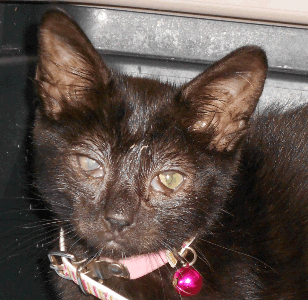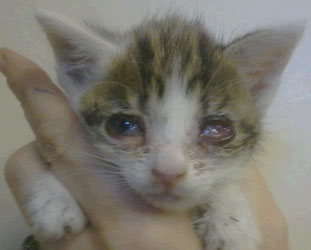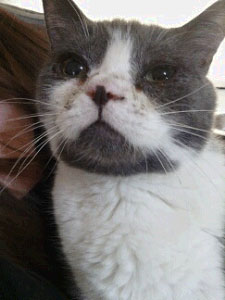Kitten with herpes conjunctivitis

Kitten with herpes infection. Note the irritated eyes. Image courtesy of Dr. Wendy Brooks.
The conjunctival membranes of the eye are basically the pink part under the eyelids and the lining of the eyelids themselves. When they are irritated, they redden and can become itchy, dry, and uncomfortable. The cornea, or clear dome-like covering of the eye, can become involved in the inflammation. It can become cloudy or even ulcerated. Tear production can be reduced, leading to a chronically dry, uncomfortable eye.
Conjunctivitis in cats is typically of viral origin, and usually, that means a herpesvirus (feline herpesvirus-1 to be specific) infection. Herpesviruses grow in the tissues of the body that interface with the environment, such as the upper respiratory tissues and conjunctivae. The infection begins with an initial phase that is usually the most severe in terms of symptoms. This phase resolves, but the virus itself does not go away; instead, it retreats into the neurologic structure in the head called the trigeminal ganglion, where the patient’s immune system holds it prisoner. In times of stress, the immune system is taxed, and the virus is able to escape from the ganglion, traveling out via the nerves exiting the ganglion. The result is the return of symptoms. In this way, the infection is permanent but the symptoms of the infections come and go.
Symptoms include conjunctivitis as described above but also nasal and respiratory symptoms such as sniffles, runny nose, and fever, basically the symptoms of an upper respiratory infection. As mentioned, the first episode is generally the worst, and subsequent episodes are more mild. Recovery typically begins after 10-14 days of symptoms, and the episode resolves within three weeks. The virus is spread by close contact (usually direct contact) with an infected cat. Herpes virus is very contagious among cats, which means that infection is very common even in cats with no symptoms.
As mentioned, the first episode is generally the worst, and subsequent episodes are more mild.
Baby Kittens: A Special Situation
Young kitten with herpes conjunctivitis

A young kitten with herpes conjunctivitis. Image courtesy of Dr. Wendy Brooks.
Herpes infection is a special problem in young kittens, especially those facing stresses beyond just their young age (fleas, poor nutrition, environmental cold, etc.).
Feral kittens, waifs of the streets, outdoor kittens, shelter kittens, etc., are all at high risk for herpes infection. Young kittens can produce so much ocular discharge that their eyes gum closed, sealing the infected secretions around the eye. It is important that the eyelids be opened manually to allow drainage of secretions as well as the application of medicine. The swelling of the conjunctivae can be so severe that the eye itself is not visible.
In severe cases, the eye can rupture and become permanently blinded. Treatment is crucial, and response to topical therapy is usually dramatic.
As mentioned, herpes infection typically causes respiratory signs as well: snotty nose, congestion, etc. These signs can result in life-threatening loss of appetite and dehydration in a young kitten, while signs are generally minor in an adult cat whose immune system is mature. Kittens with obvious discomfort should be examined by a veterinarian. Oral antibiotics will most likely be needed and sometimes hospitalization is also necessary for proper supportive care.
Adult Cats
Since kittens are so commonly affected with herpes, it is not unusual to find oneself in possession of an adult cat with a history of herpes infection. These individuals will have recurring conjunctivitis in times of stress. Typical signs include squinting slightly in one eye, a noticeable increase in eye discharge (usually brownish in color), redness of the conjunctivae, or all of the above.
Adult cat with herpes conjunctivitis

Image courtesy of Dr. Wendy Brooks.
How do we Know it is Herpes?
Basically, any infection that creates an upper respiratory infection will also cause conjunctivitis; herpes is not the only such infection. Often, several agents of upper respiratory infection are active in the same cat at the same time.
The chances are that it will not be worthwhile to determine which agents are there; it is more practical to treat bacterial agents and secondary bacterial infections first and then see if antiviral medications turn out to be needed.
Right now, the most sensitive test for herpes is PCR testing. This test is able to detect even small amounts of herpes DNA and is much more sensitive than the prior form of testing, which involved antibody levels. The problem is that herpes infection is so extremely common that most cats in any given area are going to test positive, indicating they are harboring the virus in their bodies. Having a herpes infection is not the same as having an active herpes infection, so testing a cat will determine if the cat is harboring herpes but will not determine if herpes is presently active.
So, how do we know it's herpes? We probably will not know for sure without a test but if a stressed cat has conjunctivitis involving the cornea, the chances are that herpes is afoot.
How Can we Treat it?
There are several treatment methods that can be combined in the treatment of feline herpes eye infections.
Topical Antibiotics
Topical antibiotics quell secondary bacterial invaders and are helpful in controlling the severity of symptoms because secondary bacterial infections frequently complicate Herpes conjunctivitis. It is important to realize that antibiotics do not affect the herpesvirus itself; they only work on secondary bacteria; however, often, this is enough to make the cat comfortable until the virus goes dormant.
Topical Anti-virals
There are several eye drops available that act directly against the herpes virus. They include idoxuridine (no longer commercially available and must be obtained from a compounding pharmacy); Viroptic® (trifluorothymidine); cidofovir (which also must be obtained through a compounding pharmacy), and Vira-A® (vidarabine). These medications are relatively expensive and typically require administration five times daily with the exception of cidofovir, which accumulates in the eye tissues and allows for twice daily dosing. This sounds great, but there are some toxicity issues to be reviewed if one is truly contemplating this latter therapy.
Oral Anti-virals
While antibiotics have been around for decades, antiviral medications have been much more elusive. Famciclovir was developed as a herpes treatment for humans and has been found effective for feline herpes as well. While doses and protocols are still being worked out, higher doses of oral famciclovir translate into therapeutic famciclovir levels secreted in tears, effectively creating a topical treatment from an oral product. Because the topical antivirals are frequently inconvenient to use, oral famciclovir combined with a topical antibiotic makes a fair approach to feline herpes conjunctivitis.
It should be noted that some infections lend themselves to prevention by the vaccination process, and others do not. Herpes does not; this means that vaccination of healthy cats does not prevent infection for feline herpes; what it does do is lead to less severe signs. Vaccination against feline herpes has been deemed helpful but one should understand that, in this case, the goal is not total prevention of infection but palliation.
- Probiotics
Fortiflora®, the probiotic powder made by Purina, has been found to decrease the severity of herpes conjunctivitis when added to the diet.
- Hyaluronate Eye Drops
Hyaluronate administered topically is highly supportive to the mucus-producing cells of the conjunctivae. This helps the eyes maintain proper wetness. Stabilizing the tear film in this way helps maintain not only patient comfort but also helps the eye wash away inflammatory products generated by the infection.
Eosinophilic Keratitis: A Possible Result of Chronic Infection
An especially unpleasant possible outcome of feline herpes infection involves thick white plaques forming on the surface of the eye. A scraping from the plaque can be examined under the microscope for white blood cells called eosinophils, and if they are found, the diagnosis of eosinophilc keratitis is confirmed. The plaques are an inappropriate immunologic reaction to the virus, so immune suppressive topical medications are needed to suppress the reaction. Life-long treatment is typically necessary.
Corneal Sequestrum: Another Possible Result of Chronic Infection
The Persian breed appears to be particularly predisposed to this reaction to the herpes virus. Here, a section of the cornea actually dies and turns black or dark brown. The fastest route to resolution involves surgical removal of the dead tissue and application of a tissue graft. Not all veterinarians are comfortable doing this surgery, or have the necessary equipment, so discuss with your veterinarian whether a referral to a veterinary ophthalmologist is in your and your pet’s best interest. Non-surgical management is possible with antibiotics and anti-inflammatory topicals but a specialist is best consulted should this complication of infection arise.
Can Humans get Feline Herpes? Can Cats get Human Herpes?
Thankfully, humans and cats cannot share their herpes viruses. Feline herpes is contagious among cats only, and human herpes is contagious among humans only.